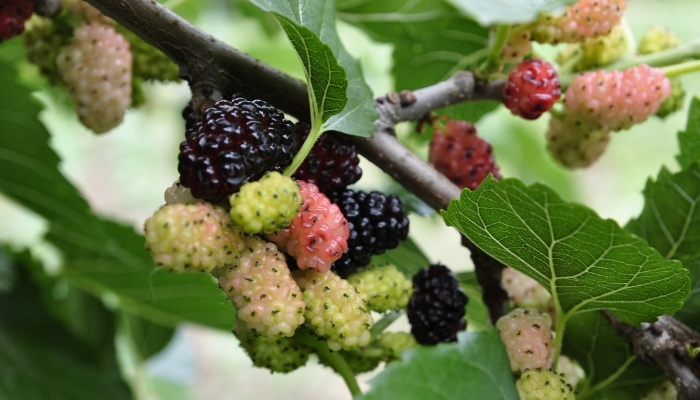The mulberry tree, although it has a similar lifespan to humans, is a medium-sized tree that provides an abundance of tasty fruits. These fruits make the effort put into cultivating and tending to the tree well worth it.
When does a mulberry tree produce fruit? If you plant the mulberry tree from seed, it would take between 5 to 6 years before it starts to produce fruits. Mulberry tree cultivar whips are quicker to mature and start fruiting 2 or 3 years from planting. The fruits ripen from early June until early August every year.
If you have problems coaxing the mulberry tree into fruiting or you’re not happy about the annual yield of the tree, read more to find out about the fruiting habits of the mulberry tree.
If you are full of questions about mulberry trees, you’re not alone. I address numerous issues, concerns, and queries in my comprehensive guide, Common Questions About Mulberries Trees. Be sure to check it out!
Mulberry Tree Fruiting – When, How Often, Harvesting
The mulberry tree is one of the easiest fruiting trees to care for. Once it establishes, it won’t bother you with excessive watering or feeding demands. However, you always get more fruits from a tree in its prime.
When Do Mulberry Trees Typically Fruit?
After the flowers of the mulberry trees are pollinated, they fade as a small fruit develops at the bottom of the flower.
The fruits will grow throughout April and May until they start to ripen as early as June. Some trees might be late bloomers, and the fruits will ripen in early August.
How Often Do Mulberry Trees Fruit Each Season?
Although the mulberry tree is known for its abundant yield annually, it only fruits once a year. Most of the fruits will be lost to birds, so you should start harvesting as soon as the fruits are ripe.
How Long Do Mulberry Trees Grown From Seed Take To Fruit?
Not all mulberry trees will mature and start fruiting at the same time. If you start the tree from seed, it will take between 5 and 6 years before it flowers and bears fruit.
Some trees might even take up to 9 years before you get the first ripe fruit. It’s not recommended to start this tree from seed for this reason.
When & How To Harvest Mulberry Fruit
The mulberry fruits don’t ripen all together at the same time. They usually have a one-month span starting from early June. Some species will start to ripen in early July or even in August.
Once most of the fruits are ripe, harvest them even if you’ll get some unripe fruits in the mix. If you wait for all the fruits to ripen, birds will pick the ripe ones, leaving little for you to harvest.
To harvest the mulberry fruit, spread a net or a clean sheet under the tree from the base to the dropline. Then hold the base of the largest branch with both hands, and shake it a few times. The fruits will drop on the sheet.
Walk around the tree shaking the laden branches, and avoid stepping on the fallen fruits.
When you’ve collected every fruit on the tree, carry the heavy sheet away for processing. The ripe fruits are fragile and damage easily, so don’t squeeze the sheet or drop it suddenly.

Do You Need Two Mulberry Trees To Produce Fruit?
You only need one mulberry tree in the garden. These trees are self-pollinating as each tree produces both male and female flowers that bloom at the same time.
The wind usually takes care of the pollination process, but you can always improve pollination by doing it manually with a small brush.
That said, having two or more mulberry trees in the garden or orchard can dramatically increase the yield of each tree due to cross-pollination.
Why Do Mulberry Trees Take So Long To Fruit?
The most likely reason that your mulberry tree is taking five or more years to fruit is that you started it from seed. Natural mulberry species are notoriously slow to mature. Some mulberry cultivars will start fruiting as early as 2 or 3 years after planting.
Average Fruit Yield of Young & Mature Mulberry Trees
The young mulberry tree that has just started fruiting will have a small annual yield averaging between 6 and 12 pounds per season, but that yield will increase year after year. A mature tree past 20 or 30 years of age will have an average yield of over 600 pounds of fruits a year.
What Is the Mulberry Tree “Fruit Drop”?
Fruit trees tend to unload some of their fruits before they’re ripe, and the mulberry tree is no exception. You’ll find the fruits all over the ground, walkway, and driveway.
Most of the fallen fruits will be picked up by birds. This often happens due to poor pollination, high winds, heavy rainfall, or diseases.
Fruit drop also occurs in mulberry trees when the tree is overladen with too many fruits that threaten to break the branches under their weight or require more resources than the tree has. The tree will shed some of the fruits.
Tips To Encourage Mulberry Tree Fruit Production
Like all fruiting trees, the mulberry tree will benefit from the right fertilizer, good growing conditions, ideal light, and cross-pollination. Here are a few tips to increase the yield of the mulberry tree.
- Plant the tree in a sunny spot that gets 6 to 8 hours of full sun in the spring and summer.
- Amend the soil in the garden to make it loamy and fast draining. The pH levels should be between 5.0 and 7.0.
- Plant more than one mulberry tree within 50 feet or less of each other to encourage cross-pollination. This can double the annual yield of each tree.
- Feed the tree with a phosphorus-rich fertilizer (this organic one is ideal) in the spring just before the first buds emerge.
- When pruning, don’t cut young branches. Flowers and fruits grow on second-year branches.
Health Benefits & Side Effects of Mulberry Fruit
The mulberry fruit is packed with vitamins and minerals that are essential to good health. This tiny fruit is reported to lower cholesterol levels in the blood, improve blood sugar control, reduce cancer risk, and prevent fatty liver disease.
You can eat as much of the delicious fruit as you like without worrying about side effects. However, the sweet fruit might raise blood sugar levels immediately after eating.
In terms of side effects, the only thing to worry about is the pollen of the tree. It might trigger an allergic reaction in people sensitive to birch pollen allergies. Wearing a mask or staying away from the tree during the bloom season is recommended.
Related Questions:
Are Mulberry Trees Illegal in Some States?
It’s a well-known fact that the mulberry tree produces tons of pollen every year. This can become a health hazard even among healthy people. Planting new mulberry trees in some cities like Phoenix, Arizona, and El Paso, Texas is now illegal for that reason.
What Are Some Common Issues With Mulberry Trees?
The most common issue you’ll have with the mulberry tree is the fruit drop, which can be messy. The trees are also self-seeding, so they can sprout new saplings where you wouldn’t want them.
Conclusion
The mulberry tree fruits once a year with fruits ripening as early as June or quite late in August. You should harvest the ripe fruits before birds devour them.
Hungry for more? Expand your mulberry tree knowledge by reading these information-packed articles next:
- How To Correctly Identify a Mulberry Tree (& Look-Alikes)
- Are Mulberry Trees Illegal? What To Know Before Planting
